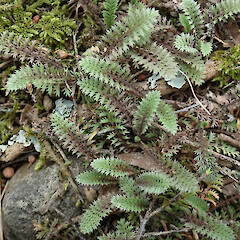Leptinella serrulata
Common name
dryland button daisy
Synonyms
Cotula serrulata D.G.Lloyd
Family
Asteraceae
Flora category
Vascular – Native
Endemic taxon
Yes
Endemic genus
No
Endemic family
No
Structural class
Herbs - Dicotyledonous composites
NVS code
The National Vegetation Survey (NVS) Databank is a physical archive and electronic databank containing records of over 94,000 vegetation survey plots - including data from over 19,000 permanent plots. NVS maintains a standard set of species code abbreviations that correspond to standard scientific plant names from the Ngä Tipu o Aotearoa - New Zealand Plants database.
LEPSER
Chromosome number
2n = 52
Current conservation status
The conservation status of all known New Zealand vascular plant taxa at the rank of species and below were reassessed in 2017 using the New Zealand Threat Classification System (NZTCS) – more information about this can be found on the NZTCS website. This report includes a statistical summary and brief notes on changes since 2012 and replaces all previous NZTCS lists for vascular plants.
Please note, threat classifications are often suggested by authors when publications fall between NZTCS assessment periods – an interim threat classification status has not been assessed by the NZTCS panel.
- Conservation status of New Zealand indigenous vascular plants, 2017 . 2018. Peter J. de Lange, Jeremy R. Rolfe, John W. Barkla, Shannel P. Courtney, Paul D. Champion, Leon R. Perrie, Sarah M. Beadel, Kerry A. Ford, Ilse Breitwieser, Ines Schönberger, Rowan Hindmarsh-Walls, Peter B. Heenan and Kate Ladley. Department of Conservation. Source: NZTCS and licensed by DOC for reuse under the Creative Commons Attribution 4.0 International licence.
2017 | At Risk – Declining | Qualifiers: DP, Sp
Previous conservation statuses
2012 | At Risk – Naturally Uncommon | Qualifiers: Sp
2009 | At Risk – Naturally Uncommon
2004 | Gradual Decline
Distribution
Endemic. new Zealand: South Island (east of the main divide from Marlborough (Wairau River) south to the Foveaux Strait, mainly well inland from Canterbury to Otago).
Habitat
Sea level to 1500 m a.s.l. Usually found in dry intermontane basins and along river flats where it grows in open sites amongst tussock grassland. More rarely coastal, where it colonises open sandy ground.
Detailed description
Dioecious, creeping, perennial herb forming small tufted patches within open grassland. Rhizomes buried, pale, wiry and glabrous; branches infrequent, usually single at flowering nodes; basally clad in scales grading up to leaves spirally-arranged and set 5–15 mm apart. Short shoots growing up from buried rhizomes, bearing 3–6 tufted leaves near apices. Roots slender, easily broken, 0.4 mm diameter. Leaves 1-pinnatifid, 7–20 × 2–6 mm; blade 6–20 mm, green, glaucous or purple-black, elliptic or obovate, submembranous, older leaves usually diffusely brown-pigmented, hairy to densely silvery-hairy, midrib raised along most of ventral surface though sometimes obscured by hairs; pinnae 8–20 pairs, close-set, overlapping, cut to rhachis, broadly obovate; teeth on all or the majority of pinnae, up to 6 per pinna, on distal margins, cut c. ½ across pinna, close-set, more or less oblong, obtuse, sometimes obscured by hairs. Peduncles villous hairy, on short shoots, about equal in length to leaves, 10–30 mm, ebracteate or bearing 1 simple bract. Pistillate capitula 2–4 mm (up to 8 mm diameter in fruit); surface convex; involucre urceolate; involucral bracts 20–40, unequally 3- or more seriate, broadly elliptic, green, villous, elongated after anthesis to enclose subglobose frutiing head; florets 30–95, 2 mm long, curved, yellow-green, corolla marginally longer than wide, dentition unequal. Staminate capitula 3–5 mm diameter; involucre hemispherical; involucral bracts 8–15, unequally uni-, or biseriate, not elongated after anthesis; florets slightly more numerous. Cypsela 1.4 × 0.8 mm, initially chartaceous and pale maturing brown and smooth, slightly compressed, unwrinkled.
Similar taxa
Leptinella pusilla Hook.f. and L. calcarea (D.G.Lloyd) D.G.Lloyd et C.J.Webb are most similar to L. serrulata. Leptinella calcarea differs by its rigidly stiff, fleshy leaves lacking any brown pigmentation, it is also geographically isolated from both L. serrulata and L. pusilla. Leptinella pusilla differs from L. serrulata by its glabrous to hairy, membranous leaves, bearing pinnae that are separated rather than overlapping, and by the pinnae teeth which are triangular rather than oblong. L. serrulata is frequently sympatric with L. pusilla.
Flowering
September–November–(January)
Flower colours
Green, Yellow
Fruiting
October–February
Propagation technique
Easy from rooted pieces and by the division of established plants. Fresh seed should germinate easily.
Threats
A lowland to montane species of open tussock grasslands. It has declined in abundance in many areas due to the spread of hawkweeds and introduced grasses, habitat modification and agricultural intensification (e.g. cultivation and irrigation).
Etymology
leptinella: From the Greek word leptos (meaning slender, thin or delicate), referring to the ovary
serrulata: Rough edged
Where To Buy
Sold by many nurseries usually by the name Cotula perpusilla cv. Platts Black. Cotula perpusilla is the same species as Leptinella pusilla.
Attribution
Fact sheet prepared for NZPCN by P.J. de Lange 31 August 2006. Description from Lloyd (1972) - as Cotula serrulata
References and further reading
Lloyd DG. 1972. A revision of the New Zealand, Subantarctic, and South American species of Cotula, section Leptinella. New Zealand Journal of Botany 10(2): 277–372. https://doi.org/10.1080/0028825X.1972.10429156.
NZPCN Fact Sheet citation
Please cite as: de Lange, P.J. (Year at time of access): Leptinella serrulata Fact Sheet (content continuously updated). New Zealand Plant Conservation Network. https://www.nzpcn.org.nz/flora/species/leptinella-serrulata/ (Date website was queried)















